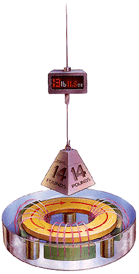|
|
|
In 1989, Dr. Ning Li, professor at the University of Alabama, Huntsville (UAH) and physicist at Marshall Space Flight Center (MSFC), hypothesized that a superconductor, when penetrated by strong magnetic field and rotated at a high rpm, would create a measurable gravitational field. The magnetic field would induce a large energy absorption within the superconductor causing small rotations in specific particles. The rotations would produce a small measurable gravitational field. (1) |
|
|
Four years after her prediction was made, Dr. Eugene Podkletnov and Nieminen accidentally discovered a 2% reduction in the weight of nonmagnetic, nonconductive objects when placed above a high Tc ceramic superconductor rotating at five thousand rpm. In addition, air pressure was decreased in a column above the superconductor. Podkletnov thought the experimental results were influenced external forces that had not been taken into account. The experiment was conducted several times with the same results. He said that "every precaution had been made". The details of Podkletnov's experiment can be found here. When Dr. Podkletnov's experiment was reexamines, it was determined that the magnetic field penetrating the disk could have caused the weight reduction that Podkletnov observed. Scientists at NASA noticed a smaller, but similar opposing gravitational effect created by a stationary disk. The force was eliminated by adding 1/2 inch. iron plate shielding. (1,2,3) |
 (http://www.popularmechanics.com/ popmech/sci/9712STSPA.gif) |
|
In order to arrive at a solid conclusion, in 1997, Dr. Ning Li began manufacturing the largest ceramic superconducting disk in the U.S. The disk has a diameter of one foot and is 1/2 inch thick. Some other pictures of Li's apparatus can be seen here. (3) |
 (http://cspar.uah.edu/www/images/grav-disk.jpg) |
|
References |
|